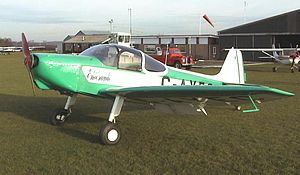Loading AI tools
1950s French light aircraft From Wikipedia, the free encyclopedia
The Piel CP-30 Emeraude (French: émeraude = "emerald") is an aircraft designed in France in the mid-1950s and widely built both by factories and homebuilders.
| Emeraude, Super Emeraude, Aeriel | |
|---|---|
 | |
| CP301A Emeraude | |
| Role | Civil utility aircraft |
| Manufacturer | Coopavia, SCANOR, SOCA, Rouchaud, Renard, CAARP, Scintex, Aeronasa, Fairtravel, Durban, Garland, homebuilders |
| Designer | Claude Piel |
| First flight | 19 June 1954 |
The Emeraude is a low-wing cantilever monoplane with fixed tailwheel undercarriage and side-by-side seating for two. The aircraft uses wood construction with a laminated box spar with an elliptical trailing edge.[1] The prototype was designed and built by Claude Piel, who then licensed manufacture of the aircraft to a number of firms, most significantly Coopavia. These early production machines were similar to the prototype, but were fitted with more powerful engines.
The first major revision of the design was the Super Emeraude, designed by Piel while working at Scintex in the early 1960s. It featured a strengthened airframe and cleaned-up aerodynamics, allowing it to be certified for aerobatics. Much of Scintex's Super Emeraude production was contracted out to CAARP, where the design eventually served as the basis for the CAP-10.
Emeraudes were also produced in the United Kingdom (by Fairtravel as the Linnet) and in South Africa by General Aircraft ("Genair") of Virginia Airport as the Aeriel 2 with imported engines,[2] the first aircraft to be manufactured entirely in that country.[3] The Linnet was modified by the Garland Aircraft Company, formed by P.A.T Garland and D.E. Bianchi, to meet British airworthiness requirements. The first aircraft (G-APNS) was built at White Waltham and first flown on 1 September 1958 by Squadron Leader Neville Duke. Two more aircraft were planned but only one more was built by Garland-Bianchi in 1962. Between 1963 and 1965 three more aircraft were built with 100-hp Rolls-Royce Continental O-200-A engines. The last two aircraft had one-piece sliding cockpit canopies.
Reviewers Roy Beisswenger and Marino Boric described the design in a 2015 review as "It is not quick to build, as the timber construction is rather complicated because of the complex forms, but in aesthetic terms it is undoubtedly a success."[4]



Data from Jane's All The World's Aircraft 1961–62[7]
General characteristics
Performance
Aircraft of comparable role, configuration, and era
Seamless Wikipedia browsing. On steroids.
Every time you click a link to Wikipedia, Wiktionary or Wikiquote in your browser's search results, it will show the modern Wikiwand interface.
Wikiwand extension is a five stars, simple, with minimum permission required to keep your browsing private, safe and transparent.